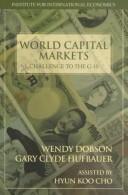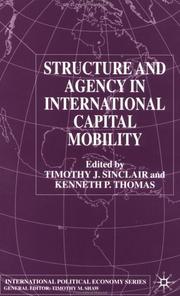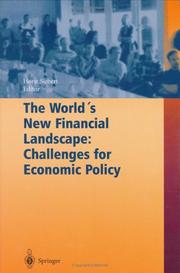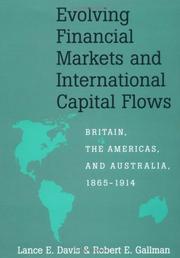| Listing 1 - 10 of 16 | << page >> |
Sort by
|
Book
ISBN: 1462351018 1452734127 1281602833 1451895186 9786613783523 Year: 2001 Publisher: Washington, D.C. : International Monetary Fund,
Abstract | Keywords | Export | Availability | Bookmark
 Loading...
Loading...Choose an application
- Reference Manager
- EndNote
- RefWorks (Direct export to RefWorks)
This paper studies the determinants of private capital flows to developing countries during the last two episodes of large inflows, the late 1970s-early 1980s and the 1990s. The paper also tests for contagion effects in capital flows among recipient countries, and tries to identify specific channels through which such effects can occur. It tests for neighborhood effects, trade-related effects, and for contagion based on the countries having similar macroeconomic indicators. The results show strong evidence for the first two effects during the 1990s, and indicate that the third effect varies depending on the type of capital flow.
Exports and Imports --- International Finance: General --- Macroeconomic Aspects of International Trade and Finance: General --- International Financial Markets --- International Investment --- Long-term Capital Movements --- Trade: General --- International economics --- Finance --- Private capital flows --- Capital flows --- Capital inflows --- Foreign direct investment --- Exports --- Balance of payments --- International trade --- Capital movements --- Investments, Foreign --- Brazil
Book
ISBN: 1280030917 9786610030910 9264192522 926418645X Year: 2001 Publisher: Paris : OECD Publishing,
Abstract | Keywords | Export | Availability | Bookmark
 Loading...
Loading...Choose an application
- Reference Manager
- EndNote
- RefWorks (Direct export to RefWorks)
The central question tackled here is that of the desirability of foreign direct investment over other flows, such as bank lending. There has been an undoubted rise in FDI flows as a proportion of all flows to the Latin American region, but how much of the cause is supply- or demand-driven remains unclear. Analyses presented in this volume appear to demonstrate that FDI is no better and no worse than other flows for growth and for crisis resistance and, in some cases, may even be a signal of an economy’s ill health. Contrary views, however, are also presented. Where governments compete for FDI, it is widely believed that they participate in a so-called "race to the bottom", lowering labour, environmental and other standards. The surprise here is that this fear is so far largely unfounded. The book also includes a glimpse of a round table discussion on these issues with private-sector participants. The Inter-American Development Bank and the OECD Development Centre created the International Forum on Latin American Perspectives as an annual meeting place of ideas and strategies from Latin America and from the OECD region. The eleventh edition of the Forum was held in Paris in November 2000 and this book contains contributions and analysis from that meeting.
Capital movements -- Latin America -- Congresses. --- Capital movements. --- Investments, Foreign -- Latin America -- Congresses. --- Investments, Foreign --- Capital movements --- Capital flight --- Capital flows --- Capital inflow --- Capital outflow --- Flight of capital --- Flow of capital --- Movements of capital --- Balance of payments --- Foreign exchange --- International finance

ISBN: 0881323012 9780881323016 Year: 2001 Publisher: Washington, D.C. Institute for International Economics
Abstract | Keywords | Export | Availability | Bookmark
 Loading...
Loading...Choose an application
- Reference Manager
- EndNote
- RefWorks (Direct export to RefWorks)
Money market. Capital market --- International finance --- Capital movements --- Capital market --- 332.042 --- International monetary system --- International money --- Finance --- International economic relations --- Capital flight --- Capital flows --- Capital inflow --- Capital outflow --- Flight of capital --- Flow of capital --- Movements of capital --- Balance of payments --- Foreign exchange --- Capital markets --- Market, Capital --- Financial institutions --- Loans --- Money market --- Securities --- Crowding out (Economics) --- Efficient market theory
Book
ISBN: 1462384404 1452736189 1281604038 9786613784728 1451891016 Year: 2001 Publisher: Washington, D.C. : International Monetary Fund,
Abstract | Keywords | Export | Availability | Bookmark
 Loading...
Loading...Choose an application
- Reference Manager
- EndNote
- RefWorks (Direct export to RefWorks)
Much of the debate about the management of financial crises has focused on structural and psychological issues regarding the conditions that are supposed to be necessary to restore investor confidence. Nonetheless, the paramount requirement in the short term is for countries in crisis to adopt correct macroeconomic policies. An analysis of conventional macroeconomic models reveals that countries can afford to run expansionary policies to restore internal balance only if they can afford to ignore the requirements for external balance. This arithmetic does not depend on whether macroeconomic policies were inappropriate before the crisis hit.
Exports and Imports --- Financial Risk Management --- Public Finance --- Macroeconomic Policy, Macroeconomic Aspects of Public Finance, and General Outlook: General --- International Monetary Arrangements and Institutions --- International Investment --- Long-term Capital Movements --- Financial Crises --- Fiscal Policy --- International economics --- Economic & financial crises & disasters --- Macroeconomics --- Capital outflows --- Financial crises --- Capital inflows --- Capital flows --- Fiscal policy --- Balance of payments --- Capital movements --- Korea, Republic of
Book
ISBN: 1462335721 145270175X 1282039377 1451904878 9786613796998 Year: 2001 Publisher: Washington, D.C. : International Monetary Fund,
Abstract | Keywords | Export | Availability | Bookmark
 Loading...
Loading...Choose an application
- Reference Manager
- EndNote
- RefWorks (Direct export to RefWorks)
This paper extends the Dornbusch model of overshooting exchange rates to discuss both exchange rate and output effects of capital controls that involve additional costs for international asset transactions. We show that, on the one hand, such capital controls have the merit of reducing the volatility of exchange rates following a monetary shock. On the other hand, the implementation increases exchange rate volatility in the short run and induces costs for the real sector in the form of lower equilibrium output levels.
Exports and Imports --- Foreign Exchange --- Current Account Adjustment --- Short-term Capital Movements --- Open Economy Macroeconomics --- International Investment --- Long-term Capital Movements --- International economics --- Currency --- Foreign exchange --- Capital controls --- Exchange rates --- Exchange rate adjustments --- Capital flows --- Capital inflows --- Balance of payments --- Capital movements --- Malaysia

ISBN: 0333725549 Year: 2001 Publisher: Basingstoke Palgrave
Abstract | Keywords | Export | Availability | Bookmark
 Loading...
Loading...Choose an application
- Reference Manager
- EndNote
- RefWorks (Direct export to RefWorks)
Capital movements --- International relations --- International finance --- #SBIB:013.IEB --- #SBIB:33H071 --- #SBIB:327.1H10 --- International monetary system --- International money --- Finance --- International economic relations --- Coexistence --- Foreign affairs --- Foreign policy --- Foreign relations --- Global governance --- Interdependence of nations --- International affairs --- Peaceful coexistence --- World order --- National security --- Sovereignty --- World politics --- Capital flight --- Capital flows --- Capital inflow --- Capital outflow --- Flight of capital --- Flow of capital --- Movements of capital --- Balance of payments --- Foreign exchange --- Economische internationale betrekkingen --- Internationale betrekkingen: theorieën --- Capital movements. --- International finance. --- International relations.

ISBN: 3540419926 Year: 2001 Publisher: Berlin Springer
Abstract | Keywords | Export | Availability | Bookmark
 Loading...
Loading...Choose an application
- Reference Manager
- EndNote
- RefWorks (Direct export to RefWorks)
Capital movements --- Financial crises --- International finance --- AA / International- internationaal --- 333.600 --- -Capital movements --- -Financial crises --- -332.042 --- Crashes, Financial --- Crises, Financial --- Financial crashes --- Financial panics --- Panics (Finance) --- Stock exchange crashes --- Stock market panics --- Crises --- Business cycles --- Capital flight --- Capital flows --- Capital inflow --- Capital outflow --- Flight of capital --- Flow of capital --- Movements of capital --- Balance of payments --- Foreign exchange --- International monetary system --- International money --- Finance --- International economic relations --- Financiële markten. Kapitaalmarkten (algemeenheden). --- 332.042 --- Financiële markten. Kapitaalmarkten (algemeenheden)
Book
ISBN: 1462323618 145271486X 1282106244 9786613799593 1451905025 Year: 2001 Publisher: Washington, D.C. : International Monetary Fund,
Abstract | Keywords | Export | Availability | Bookmark
 Loading...
Loading...Choose an application
- Reference Manager
- EndNote
- RefWorks (Direct export to RefWorks)
This paper explores the ability of portfolio and foreign direct investment flows to track movements in the euro and the yen against the dollar. Net portfolio flows from the euro area into U.S. stocks—possibly reflecting differences in expected productivity growth—track movements in the euro against the dollar closely. Net FDI flows, which capture the recent burst in cross-border M&A activity, appear less important in tracking movements in the euro-dollar rate, possibly because many M&A transactions consist of share swaps. Movements in the yen versus the dollar remain more closely tied to such conventional variables as the current account and interest differential.
Exports and Imports --- Foreign Exchange --- Investments: Stocks --- Money and Monetary Policy --- Current Account Adjustment --- Short-term Capital Movements --- International Investment --- Long-term Capital Movements --- Pension Funds --- Non-bank Financial Institutions --- Financial Instruments --- Institutional Investors --- Monetary Systems --- Standards --- Regimes --- Government and the Monetary System --- Payment Systems --- International economics --- Currency --- Foreign exchange --- Investment & securities --- Monetary economics --- Exchange rates --- Capital flows --- Current account --- Stocks --- Currencies --- Balance of payments --- Financial institutions --- Money --- Capital movements --- United States
Book
ISBN: 1462311504 1452718903 1282110233 1451905122 9786613803122 Year: 2001 Publisher: Washington, D.C. : International Monetary Fund,
Abstract | Keywords | Export | Availability | Bookmark
 Loading...
Loading...Choose an application
- Reference Manager
- EndNote
- RefWorks (Direct export to RefWorks)
This paper documents trends in movement and composition of capital flows into India in a comparative perspective, examines the impact of these flows upon key macroeconomic variables in the economy, and dwells on implications for economic policy. We find that an inflow of foreign capital results in a real appreciation and has a significant impact on domestic money supply. During a capital surge, these effects have been countered through intervention and sterilization. The paper concludes with a discussion on the costs of these policies in the event of a heavy inflow of foreign capital into India.
Banks and Banking --- Exports and Imports --- Foreign Exchange --- Money and Monetary Policy --- Monetary Policy, Central Banking, and the Supply of Money and Credit: General --- Macroeconomic Policy, Macroeconomic Aspects of Public Finance, and General Outlook: General --- International Finance: General --- International Investment --- Long-term Capital Movements --- Monetary Policy --- International economics --- Currency --- Foreign exchange --- Monetary economics --- Banking --- Capital inflows --- Real exchange rates --- Capital flows --- Monetary base --- International reserves --- Balance of payments --- Money --- Central banks --- Capital movements --- Money supply --- Foreign exchange reserves --- India

ISBN: 0521553520 052116608X 0511116306 0511065655 0511059345 0511327706 051151087X 1280159901 1139145568 051106778X 1107112818 9780511065651 9780511116308 9780511510878 9780511067785 9781280159909 9780521553520 9781107112810 9781139145565 9780511059346 9780511327704 9780521166089 Year: 2001 Volume: *2 Publisher: Cambridge Cambridge University Press
Abstract | Keywords | Export | Availability | Bookmark
 Loading...
Loading...Choose an application
- Reference Manager
- EndNote
- RefWorks (Direct export to RefWorks)
This 2001 study examines the impact of British capital flows on the evolution of capital markets in four countries - Argentina, Australia, Canada, and the United States - over the years 1870 to 1914. In substantive chapters on each country it offers parallel histories of the evolution of their financial infrastructures - commercial banks, non-bank intermediaries, primary security markets, formal secondary security markets, and the institutions that provide the international financial links connecting the frontier country with the British capital market. At one level, the work constitutes a quantitative history of the development of the capital markets of five countries in the late nineteenth century. At a second level, it provides the basis for a useable taxonomy for the study of institutional invention and innovation. At a third, it suggests some lessons from the past about modern policy issues.
Capital movements. --- Capital movements--History. --- Investments, British. --- Investments, British --- Capital movements --- Investment & Speculation --- Finance --- Business & Economics --- History --- Business, Economy and Management --- Economics --- History. --- Capital flight --- Capital flows --- Capital inflow --- Capital outflow --- Flight of capital --- Flow of capital --- Movements of capital --- British investments --- Balance of payments --- Foreign exchange --- International finance --- Investments [British ] --- GB / United Kingdom - Verenigd Koninkrijk - Royaume Uni --- AR / Argentina - Argentinië - Argentine --- US / United States of America - USA - Verenigde Staten - Etats Unis --- CA / Canada --- AU / Australia - Australië - Australie --- AA / International- internationaal --- 331.160 --- Financiële geschiedenis: algemeenheden
| Listing 1 - 10 of 16 | << page >> |
Sort by
|

 Search
Search Feedback
Feedback About UniCat
About UniCat  Help
Help News
News